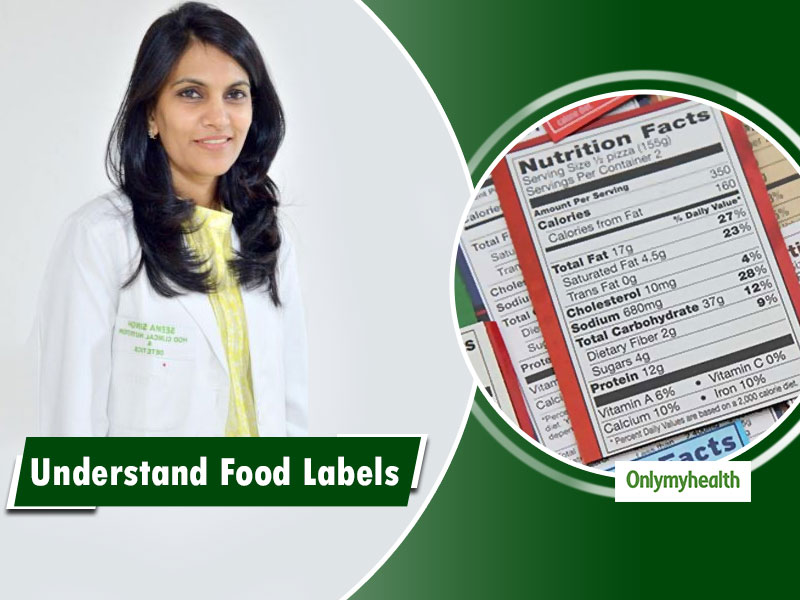
Food labels offer an abundance of information, yet many people do not take the time or do not understand how to read the labels on their food products. Reading food labels can be tricky but remember Understanding the information on your food labels is the key to making healthy food choices. Reading labels intelligently can help you make informed food choices.
Table of Content:-
Packaged foods and drinks have a lot of nutrition and food safety information on their labels or packaging. The smart consumer should always check these points.
Nutrition Fact Panel
- A Nutrition Label identifies the nutrients found in a portion of food, like calories, protein, and vitamins.
- Identifying products LOW in fat, saturated fat, trans fat and sodium as per the following thresholds.
- LOW FAT <=3g/100 g for solids <= 1.5g/100ml for liquids.
- LOW SATURATED FAT The sum of saturated fat and trans fat <=1.5g/100g for solids, The sum of saturated fat and trans fat <=0.75g/100ml for liquids.
- LOW TRANS FAT <=0.2/100g.
- LOW SODIUM <=0.12g/100g for solids, <=0.12g/100ml for liquids.
- LOW SUGAR <=5g/100 g for solids, <=2.5g/100ml for liquids.
- No added sugar: No sugars have been added but the product may have natural sugars present
- High fiber: Contains at least 6g
Check Added Sugars
Also Read: 3 Foot Stretches That Are Recommended By Every Podiatrist

In addition to showing the total percentage of calories from sugars, labels will show the percentage from added sugars. This will help you choose products that have lower amounts of added sugar for your diet. Less than 10% of your daily calories should be from added sugars.
Check %DV
- It means “Daily Value” and the percent will range from 0 to 100.
- %DV is an estimate of how much of a particular nutrient you are eating with one serving of food. However, it’s based on a 2,000 calorie a day diet, whereas the average person needs may vary.
- Also, this is the FDA’s estimate of how many vitamins and minerals you need. Use %DV as a starting point only.
Here are some guidelines
- Less than 5% DV isn’t that much.
- More than 20% of DV is a lot.
Also Read: At-Home Cardio Exercises For Beginners
Check Nutritional Facts as per serving size
![]()
NFP is usually given as "per 100g" or "per serving" or a combination of both. The serving size on the label is not a recommendation of how much to eat. Serving size reflects what people are likely to eat or drink today and not necessarily the portions they should eat. If the serving size is equal to the amount you consumed/will consume, it will provide the same number of calories and nutrients mentioned on the Nutrition Facts Panel. If the amount consumed is less or more than mentioned in the NFP, then you need to calculate the nutrients consumed.
Ingredients List

- Pay attention to the ingredients list. This tells you exactly what you’re eating. Because the front of the package can’t be trusted. Ingredients list states the food composition of the package. The ingredients list can also help you work out how healthy the product is.
- The ingredients should be placed in decreasing order of their weight expressed in percentages. That means that if the first few ingredients are high-fat ingredients, such as cream, butter or oil, then the food in question is a high-fat food.
- If ingredients like sugar, fat/oil, salt, monosodium glutamate or their alternative sources appear in 1st, 2nd or 3rd position then the food may be unhealthy.
- If there is more than one source of fat, sodium, MSG and sugar or their alternative sources, the food may be unhealthy If ingredients are not given in percentages then pay attention to the order of the ingredients.
Allergen Declaration
- Allergen declaration on the food labels helps in avoiding food allergies.
- FSSAI requires food labels to mention the allergen sources incorporated in the food as an ingredient or manufactured in the facility which may have incorporated it.
Best before Date
- It is the date which informs that if the food is not consumed by this specified date, it may lose its freshness, taste, aroma or nutrients.
- It does not necessarily mean that the food is no longer safe to eat, but the organoleptic qualities are compromised e.g. Best before 6 months from packaging.
- Always check Date of Manufacture, it is the date when the finished product is produced and packaged.
(With inputs from Seema Singh, Chief Clinical Nutritionist and Head of Department, Fortis Hospital Vasant Kunj)
Read more articles on Miscellaneous
How we keep this article up to date:
We work with experts and keep a close eye on the latest in health and wellness. Whenever there is a new research or helpful information, we update our articles with accurate and useful advice.
Current Version
